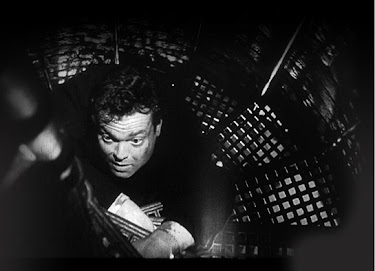Directed by: Lewis Milestone
Written by: John Patrick (story), Robert Rossen (screenplay), Robert Riskin (uncredited)
Starring: Barbara Stanwyck, Van Heflin, Lizabeth Scott, Kirk Douglas, Judith Anderson, Darryl Hickman, Janis Wilson
 Lewis Milestone's The Strange Love of Martha Ivers (1946) is filled with Gothic atmosphere, the sort of hushed melodramatic whispers that follow around a household with something to hide – think Rebecca (1940) or Dragonwyck (1946). But the film never reaches its potential. Despite a running-time of nearly two hours, by the story's end, I felt as though nothing much had really happened, and that a perfectly good build-up had been smothered before reaching its climax and logical conclusion. There's no doubt that Barbara Stanwyck was cast in light of her icy Oscar-nominated performance in Double Indemnity (1944), but here it's uncertain whether her character is a tormented victim or a compassionless fiend. Such ambiguity might have been used to great effect, but here it merely suggests a confused script that can't decide whether to idolise or chastise its top-billed performer. Not to mention that Stanwyck herself doesn't appear until past the film's half- hour mark, the delay promising a colossal personality that eventually materialises only half-heartedly.
Lewis Milestone's The Strange Love of Martha Ivers (1946) is filled with Gothic atmosphere, the sort of hushed melodramatic whispers that follow around a household with something to hide – think Rebecca (1940) or Dragonwyck (1946). But the film never reaches its potential. Despite a running-time of nearly two hours, by the story's end, I felt as though nothing much had really happened, and that a perfectly good build-up had been smothered before reaching its climax and logical conclusion. There's no doubt that Barbara Stanwyck was cast in light of her icy Oscar-nominated performance in Double Indemnity (1944), but here it's uncertain whether her character is a tormented victim or a compassionless fiend. Such ambiguity might have been used to great effect, but here it merely suggests a confused script that can't decide whether to idolise or chastise its top-billed performer. Not to mention that Stanwyck herself doesn't appear until past the film's half- hour mark, the delay promising a colossal personality that eventually materialises only half-heartedly.
Stanwyck may be slightly disappointing, but fortunately the men are willing to hold the fort. Kirk Douglas, in his debut, does an excellent job of merging faux-authority and jittery cowardice for his role as Walter O'Neil, Martha's sycophantic District-Attorney husband. But the real surprise of the picture is Van Heflin, the last actor I would have chosen to play a noir "tough guy." As roving gambler Sam Masterson, Heflin channels the cocky vigour of Philip Marlowe, constantly stepping into trouble just for the hell of it, if only to flout the authority of those who try to rough him up. Lizabeth Scott is unfortunately weak in an undemanding romantic role. She has a bit of Lauren Bacall about her, which is regrettable because I can imagine Bacall being far better in the role {and I mustn't be the only one who saw a resemblance, because Scott was soon paired with Bogart in Dead Reckoning (1947)}. In a lengthy opening prologue, the three main characters (as teenagers) are well played by Janis Wilson, Mickey Kuhn and Darryl Hickman (from Leave Her to Heaven (1945)).
Film noirs typically unfold in the impersonal urban decadence of a large city, but here Martha Ivers' grip on a small town (appropriately named Iverstown) is used to excellent effect. Unlike Hitchcock's Shadow of a Doubt (1943), in which the presence of a serial killer "pollutes" an idealistic country town from the inside, the audience realises that Iverstown may already be beyond saving. Corruption is built in the town's foundations. A self-serving District Attorney, spurred on by his dominating wife, knowingly sends an innocent man to his death, and uses hired thugs to hide his own crimes. Walter's paranoia regarding the arrival of Sam Masterson is used to good ironic effect, as he later realises that, had it not been for his impatience to get rid of him, Sam would never have uncovered their dirty secret. Martha, displaying that maddening ambiguity again, seems to be halfway between loving and hating Sam, if only because his toughness and charm reminds her of the future she might have enjoyed if she hadn't snatched that cane from the hands of her aunt.6.5/10
Currently my #10 film of 1946:
1) It’s A Wonderful Life (Frank Capra)
2) The Big Sleep (Howard Hawks) *
3) Duel in the Sun (King Vidor)
4) Notorious (Alfred Hitchcock) *
5) The Locket (John Brahm) *
6) Crack-Up (Irving Reis) *
7) The Dark Mirror (Robert Siodmak) *
8) The Blue Dahlia (George Marshall) *
9) Dragonwyck (Joseph L. Mankiewicz) *
10) The Strange Love of Martha Ivers (Lewis Milestone) *
 WARNING: Plot and/or ending details may follow!!! [Paragraph 3 Only]
WARNING: Plot and/or ending details may follow!!! [Paragraph 3 Only] Most noir enthusiasts would, I'm sure, agree that the modern heist thriller was basically born with John Huston's The Asphalt Jungle (1950). But it wasn't alone for long. Just one month after its release, Richard Fleischer released his own heist flick, a low-budget B-movie with no star power (unless you count supporting player Charles McGraw, who was no stranger to film noir – see
Most noir enthusiasts would, I'm sure, agree that the modern heist thriller was basically born with John Huston's The Asphalt Jungle (1950). But it wasn't alone for long. Just one month after its release, Richard Fleischer released his own heist flick, a low-budget B-movie with no star power (unless you count supporting player Charles McGraw, who was no stranger to film noir – see 




_poster.jpg)

